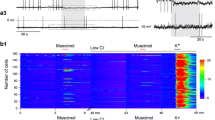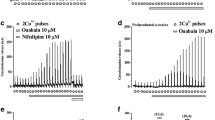Summary
-
1.
Effects of imidazole compounds and guanabenz on the stimulus-evoked release of catecholamine (CA) were studied in cultured bovine adrenal chromaffin cells.
-
2.
Clonidine, oxymetazoline, phentolamine, chlorpheniramine, and guanabenz inhibited acetylcholine (ACh)-evoked CA release in a dose-dependent manner, but not high K+-evoked release.
-
3.
The inhibition by these compounds was not antagonized by nonimidazole and nonguanidineα 2-antagonists (yohimbine and phenoxybenzamine) but was significantly antagonized by tolazoline (imidazoleα 2-antagonist) and cimetidine (imidazole H2-antagonist). Moreover, tolazoline by itself augmented the ACh-evoked, but not the high K+-evoked, CA release.
-
4.
Although chlorpheniramine and cimetidine are antagonists for H1 and H2 histaminergic receptors, the site of action for these compounds in our results seemed to differ from the histamine receptors.
-
5.
These results suggest that the inhibitory action of imidazole compounds and guanabenz on ACh-evoked CA release in adrenal chromaffin cells is mediated through an imidazole receptor. Adrenal chromaffin cells may contain an endogenous clonidine-displacing substance (CDS) which has been found in adrenal gland and brain as an endogenous ligand for imidazole receptors. Thus, CDS may have a regulatory role in the stimulus-secretion coupling in these cells.
Similar content being viewed by others
References
Atlas, D., and Burstein, Y. (1984). Isolation and partial purification of a clonidine-displacing endogenous brain substance.Eur. J. Biochem. 144287–293.
Atlas, D., Diamant, S., Fales, H. M., and Pannell, L. (1987). The brain's own clonidine: Purification and characterization of endogenous clonidine-displacing substance from brain.J. Cardiovasc. Pharmacol. 10 (Suppl. 12):S122.
Bommer, M., Liebisch, D., Kley, N., Herz, A., and Noble, E. (1987). Histamine affects release and biosynthesis of opioid peptides primarily via H1-receptors in bovine chromaffin cells.J. Neurochem. 491688–1696.
Bousquet, P., and Schwartz, J. (1983). Alpha-adrenergic drugs: Pharmacological tools for the study of the central vasomotor control.Biochem. Pharmacol. 321459–1465.
Cull-Candy, S. G., Mathie, A., and Powis, D. A. (1988). Acethylcholine receptor channels and their block by clonidine in cultured bovine chromaffin cells.J. Physiol. Lond. 402255–278.
Ernsberger, P., Meeley, M. P., Mann, J. J., and Reis, D. J. (1987). Clonidine binds to imidazole binding sites as well asα 2-adrenoceptors in the ventrolateral medulla.Eur. J. Pharmacol. 1341–13.
Ernsberger, P., Giuliano, R., Willette, R. N., Granata, A. R., and Reis, D. J. (1988a). Hypotensive action of clonidine analogues correlates with binding affinity at imidazole and not alpha-2-adrenergic receptors in the rostral ventrolateral medulla.J. Hypertens. 6 (Suppl. 4):S554-S557.
Ernsberger, P., Meeley, M. P., and Reis, D. J. (1988b). An endogenous substance with clonidine-like properties: Selective binding to imidazole sites in ventrolateral medulla.Brain Res. 441309–318.
Ernsberger, P., Feinland, G., Evinger, M. J., Meeley, M. P., and Reis, D. J. (1989). Adrenal chromaffin cells express clonidine-specific imidazole receptors which bind an endogenous clonidine-displacing substance.Am. J. Hypertens. 2:93A.
Ernsberger, P., Giuliano, R., Willette, R. N., and Reis, D. J. (1990). Role of imidazole receptors in the vasodepressor response to clonidine analogs in rostral ventrorateral medulla.J. Pharmacol. Exp. Ther. 253408–418.
Evinger, M. J., Ernsberger, P., Hoh, T., and Reis, D. J. (1989). Clonidine regulates PNMT gene expression in chromaffin cells cultures.Soc. Neurosci. Abstr. 15500.
Felsen, D., Ernsberger, P., Meeley, M. P., and Reis, D. J. (1987). Clonidine displacing substance is biologically active on smooth muscle.Eur. J. Pharmacol. 142453–455.
Greenberg, A., and Zinder, O. (1982).α- andβ-receptor control of catecholamine secretion from isolated adrenal medulla cells.Cell Tissue Res. 226655–665.
Hensley, M. L., Meeley, M. P., McCauley, P. M., Ernsberger, P., and Reis, D. J. (1989). Clonidine-displacing substance is present in peripheral tissues of the rat.Am. J. Hypertens. 2917–919.
Kumakura, K., Ohara, M., and Satô, G. P. (1986). Real-time monitoring of the secretory function of cultured adrenal chromaffin cells.J. Neurochem. 461851–1858.
Meeley, M. P., Ernsberger, P. R., Granata, A. R., and Reis, D. J. (1986). An endogenous clonidine-displacing substance from bovine brain: Receptor binding and hypotensive actions in the ventrolateral medulla.Life Sci. 381119–1126.
Michel, M. C., and Insel, P. A. (1989). Are there multiple imidazoline binding sites?Trends Pharmacol. Sci. 10342–344.
Nguyen, T. T., and De Léan, A. (1987). Noradrenergic modulation by clonidine of the cosecretion of catecholamines and enkephalins in adrenal chromaffin cells.Can. J. Physiol. Pharmacol. 65823–827.
Noble, E. P., Bommer, M., Liebisch, D., and Herz, A. (1988). H1-histaminergic activation of catecholamine release by chromaffin cells.Biochem. Pharmacol. 37221–228.
O.-Imaizumi, M., Miyakawa, Y., and Kumakura, K. (1988). Pertussis toxin attenuates clonidine inhibition of catecholamine release in adrenal chromaffin cells.Neurosci. Lett. 93294–299.
Orts, A., Orellana, C., Cantó, T., Ceña, V., González-Garcia, C., and Garcia, A. G. (1987). Inhibition of adrenomedullary catecholamine release by propranolol isomers and clonidine involving mechanism unrelated to adrenoceptors.Br. J. Pharmacol. 92795–801.
Powis, D. A., and Baker, P. F. (1986).α 2-Adrenoceptors do not regulate catecholamine secretion by bovine adrenal medullary cells: A study with clonidine.Mol. Pharmacol. 29134–141.
Sakurai, S., Wada, A., Izumi, F., Kobayashi, H., and Yanagihara, N. (1983). Inhibition byα 2-adrenoceptor agonists of the secretion of catecholamines from isolated adrenal medullary cells.Naunyn-Schmiedeberg Arch. Pharmacol. 32415–19.
Wada, A., Sakurai, S., Kobayashi, H., Yanagihara, N., and Izumi, F. (1982).α 2-Adrenergic receptors inhibit catecholamine secretion from bovine adrenal medulla.Brain Res. 252189–191.
Author information
Authors and Affiliations
Rights and permissions
About this article
Cite this article
Ohara-Imaizumi, M., Kumakura, K. Effects of imidazole compounds on catecholamine release in adrenal chromaffin cells. Cell Mol Neurobiol 12, 273–283 (1992). https://doi.org/10.1007/BF00712931
Received:
Accepted:
Issue Date:
DOI: https://doi.org/10.1007/BF00712931




